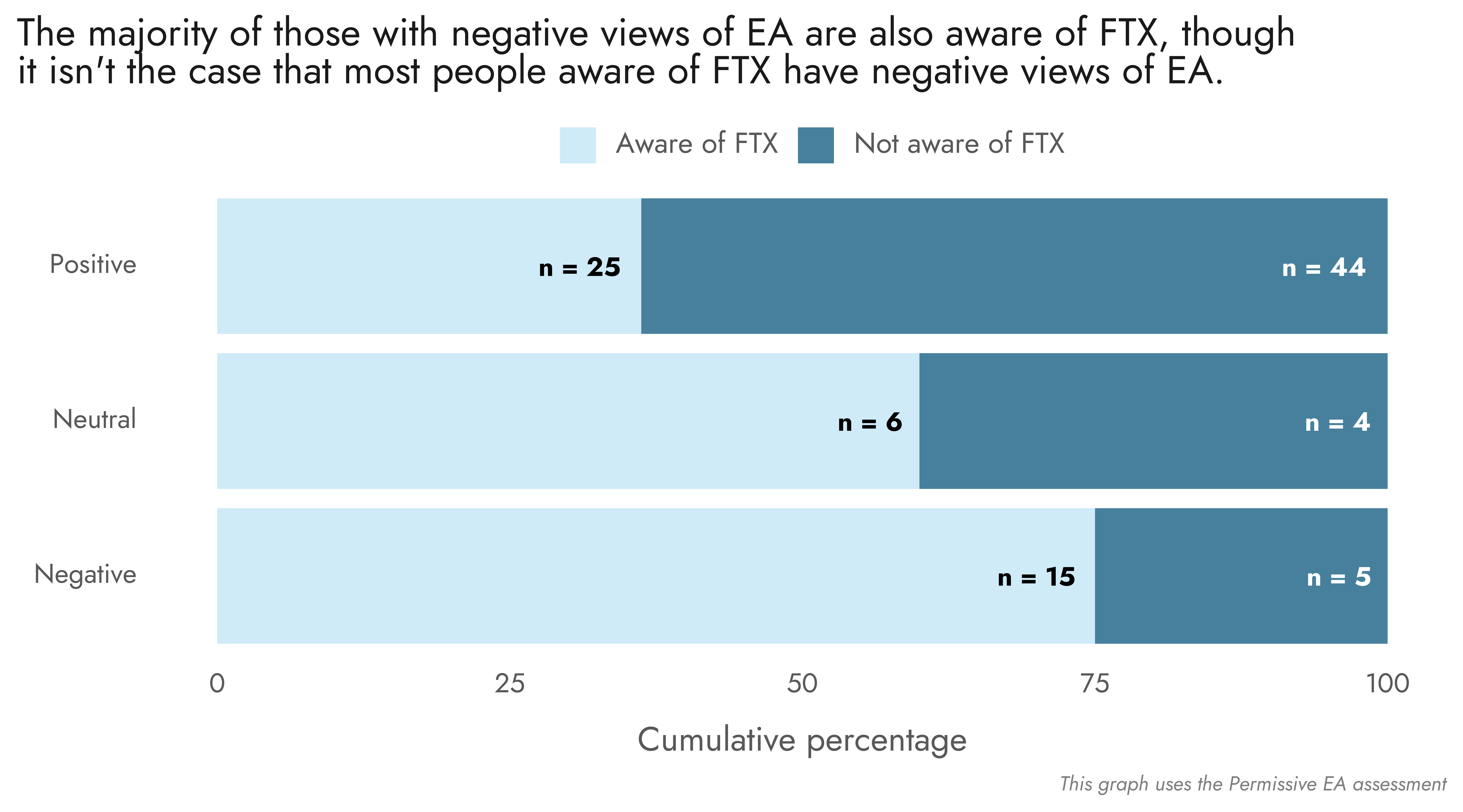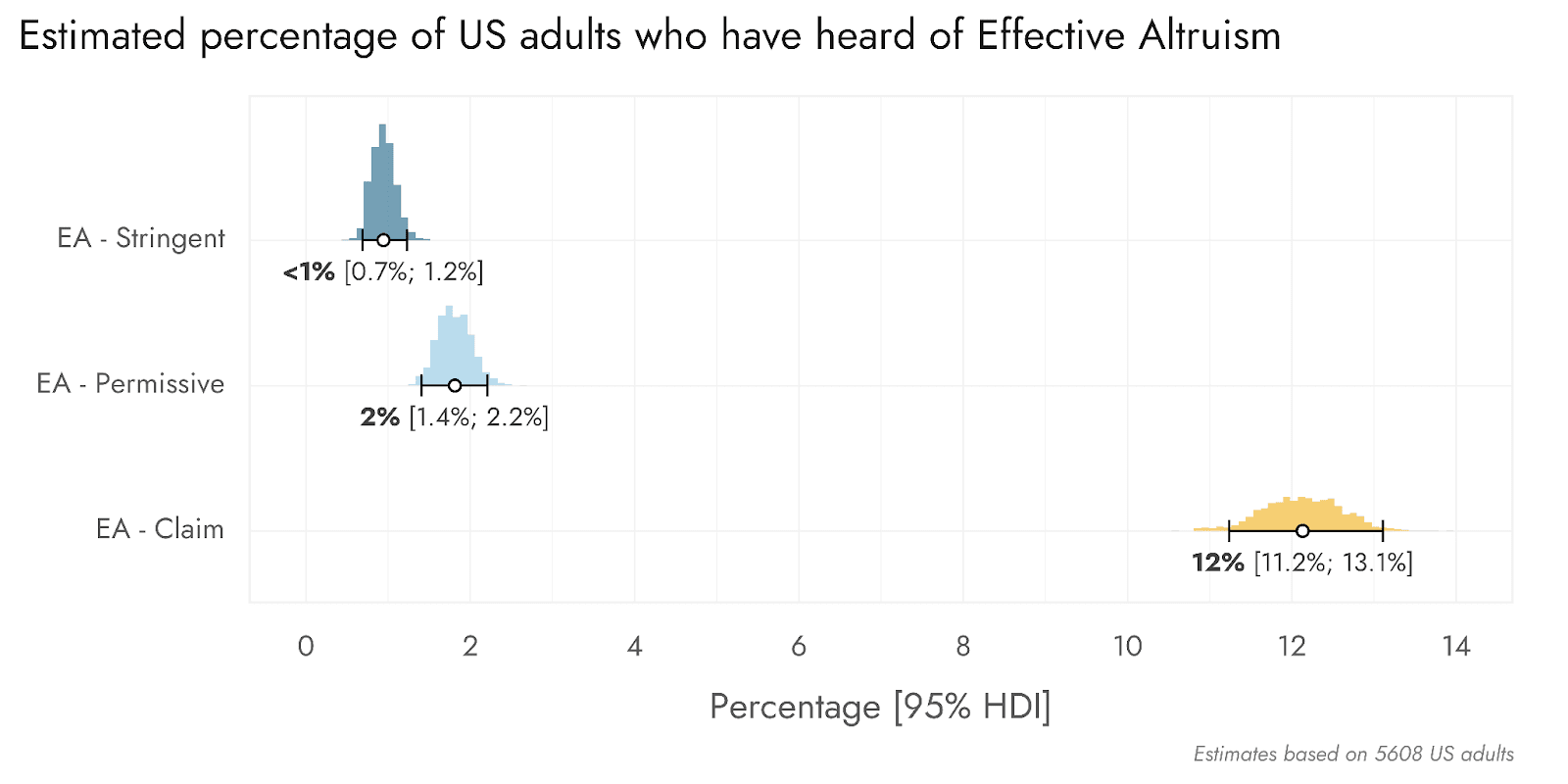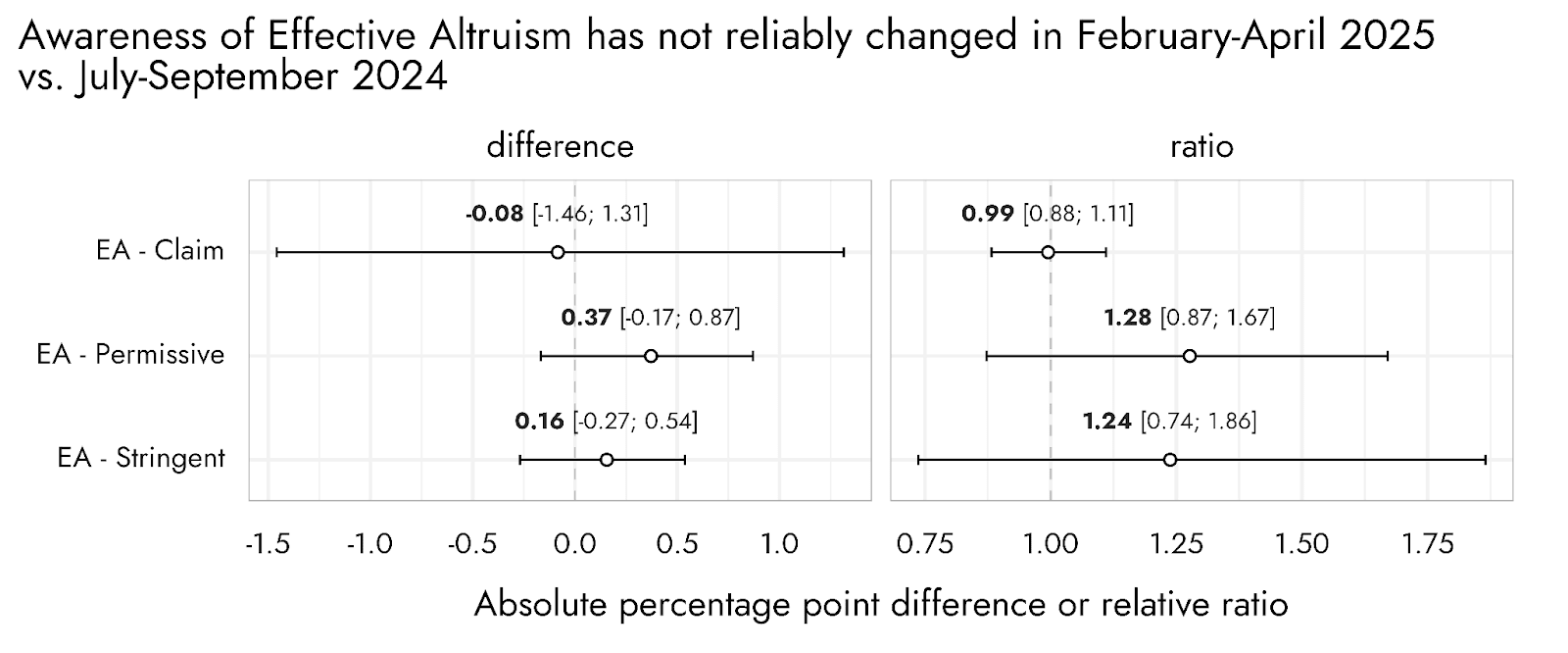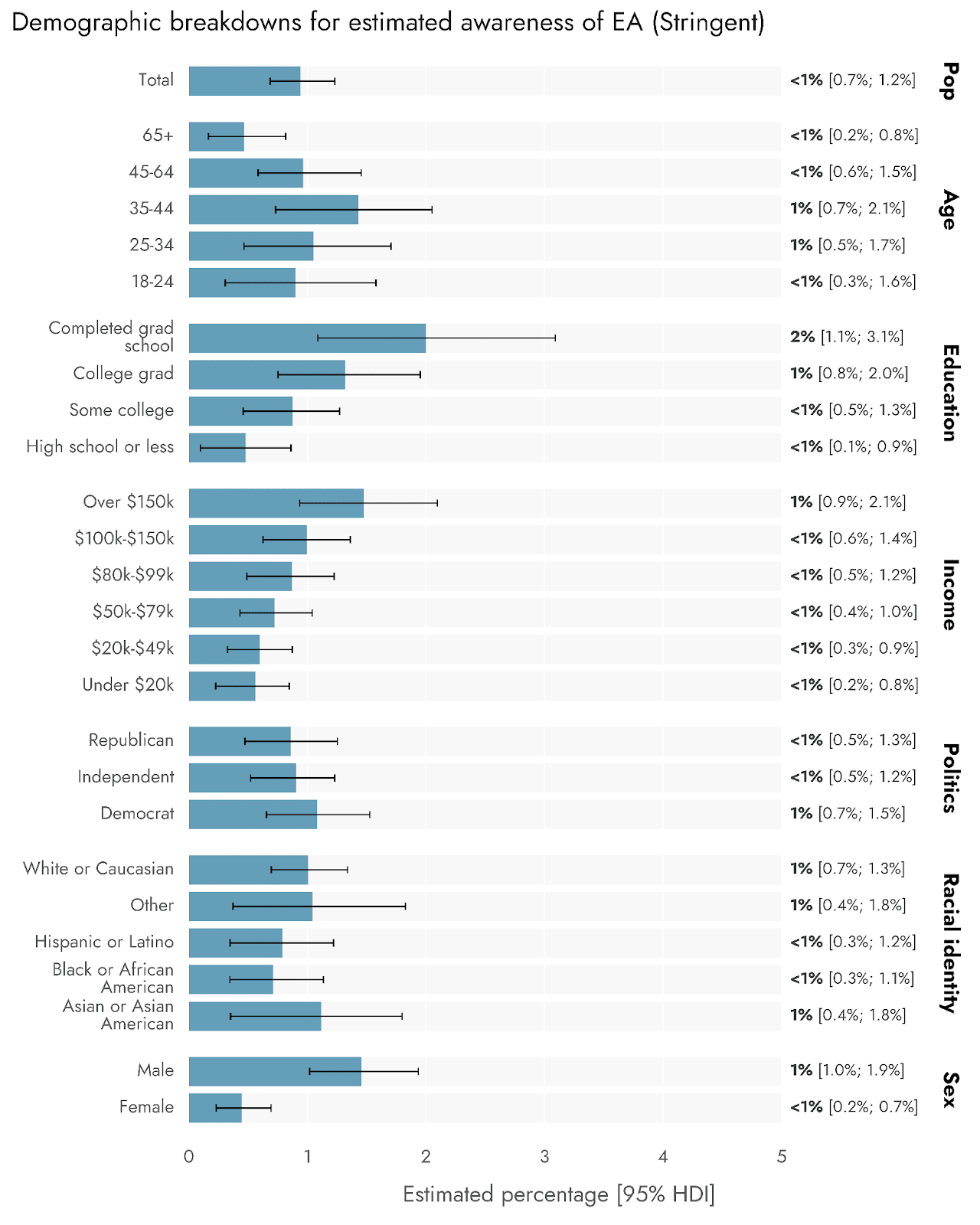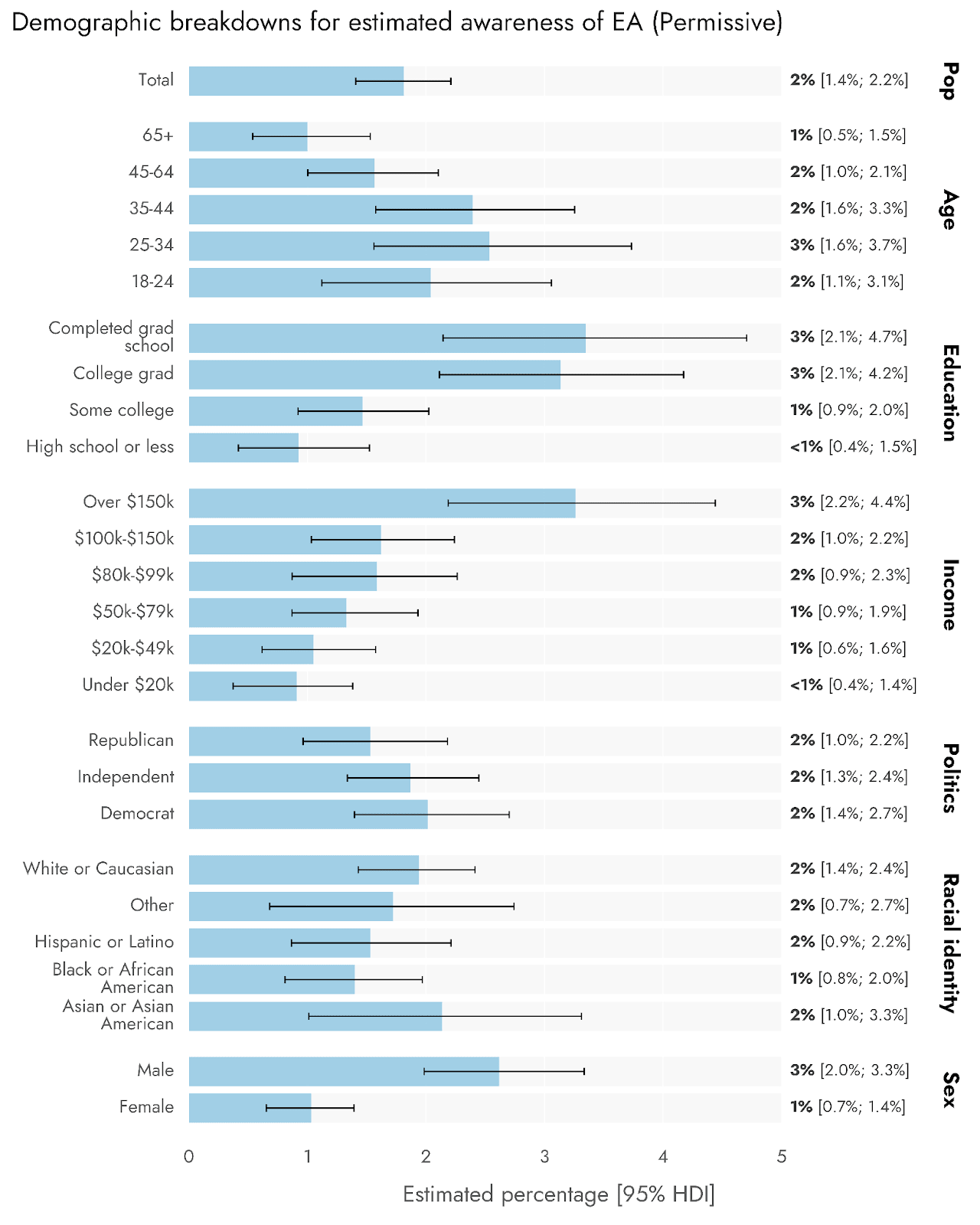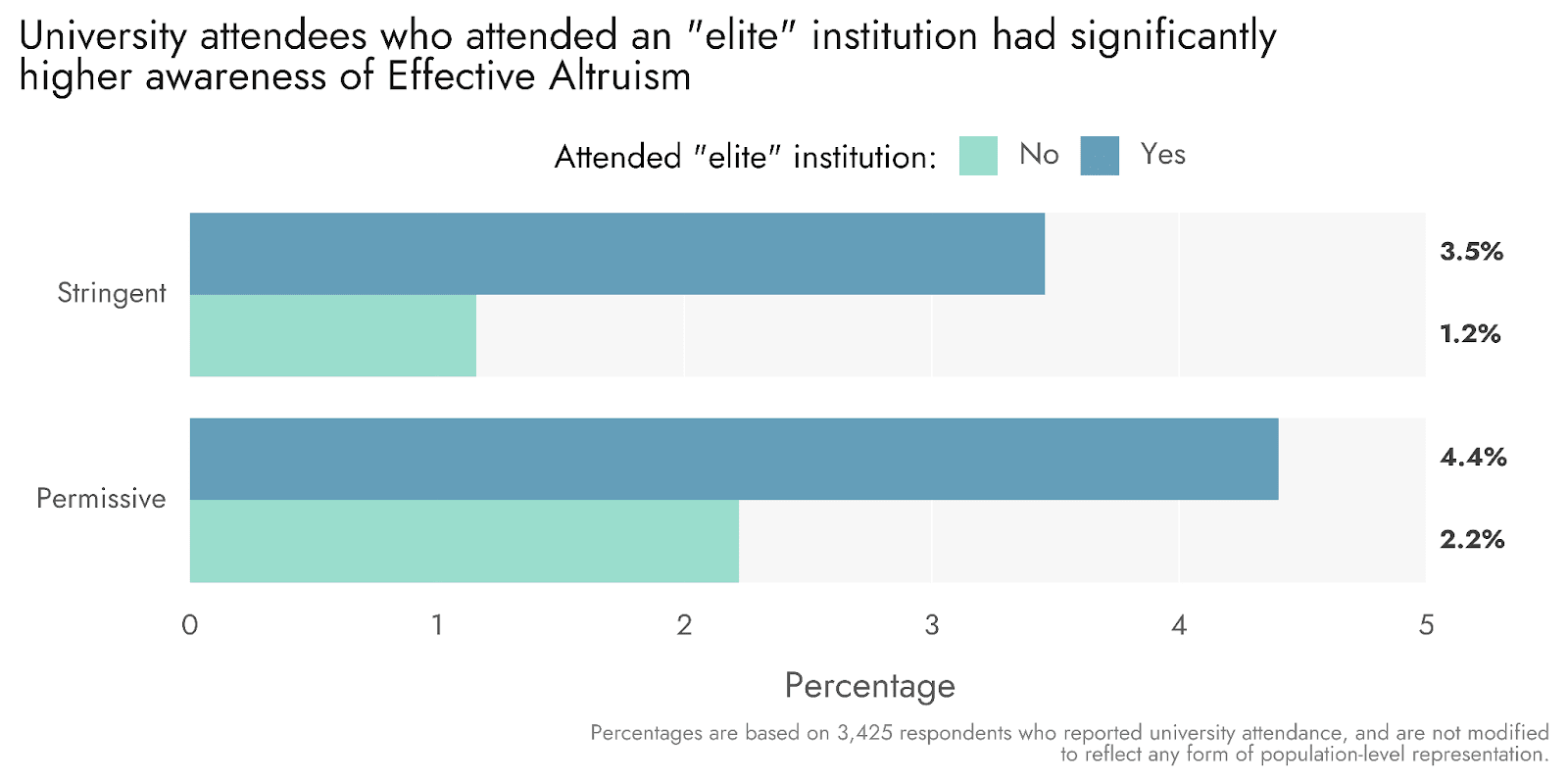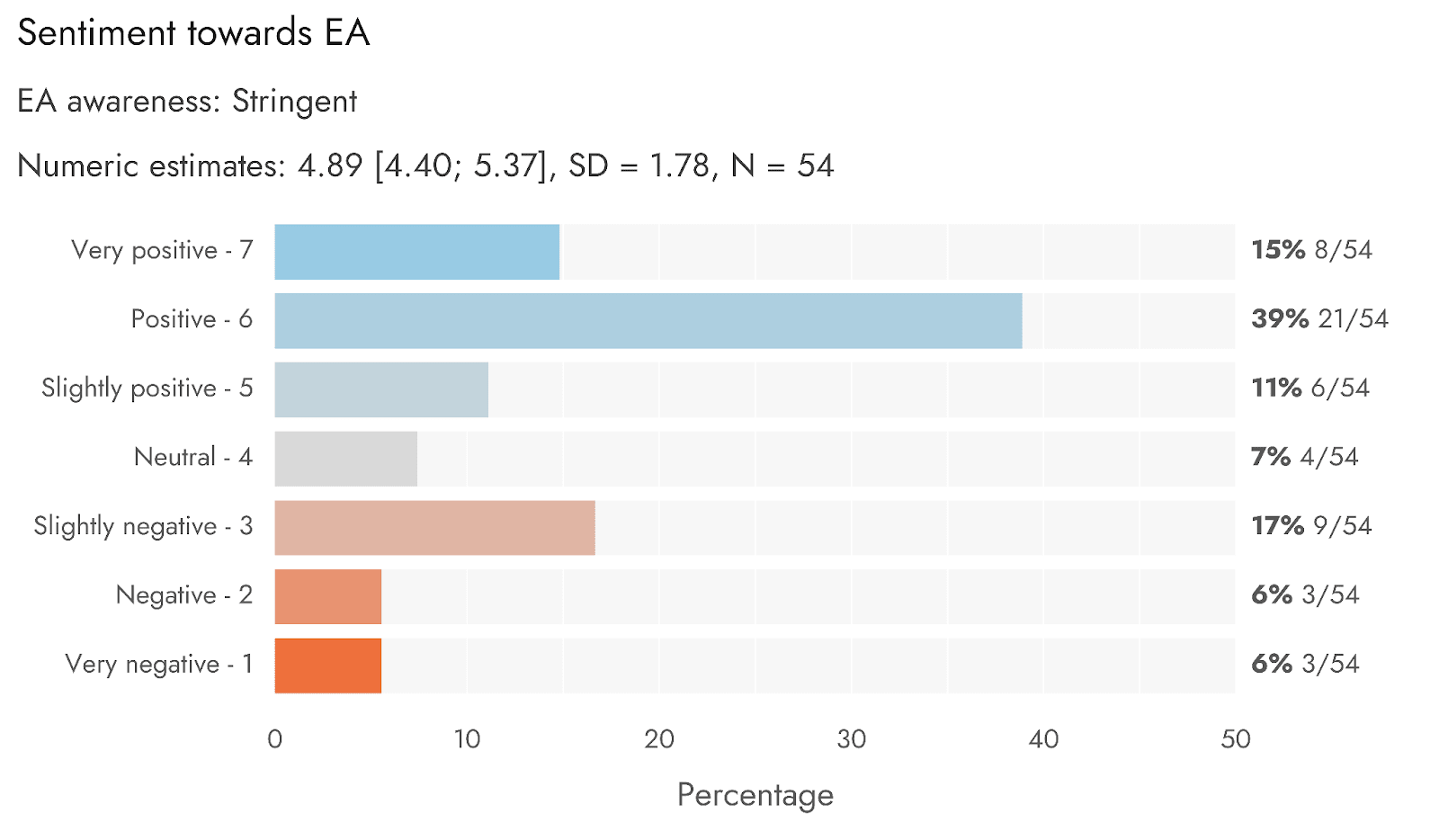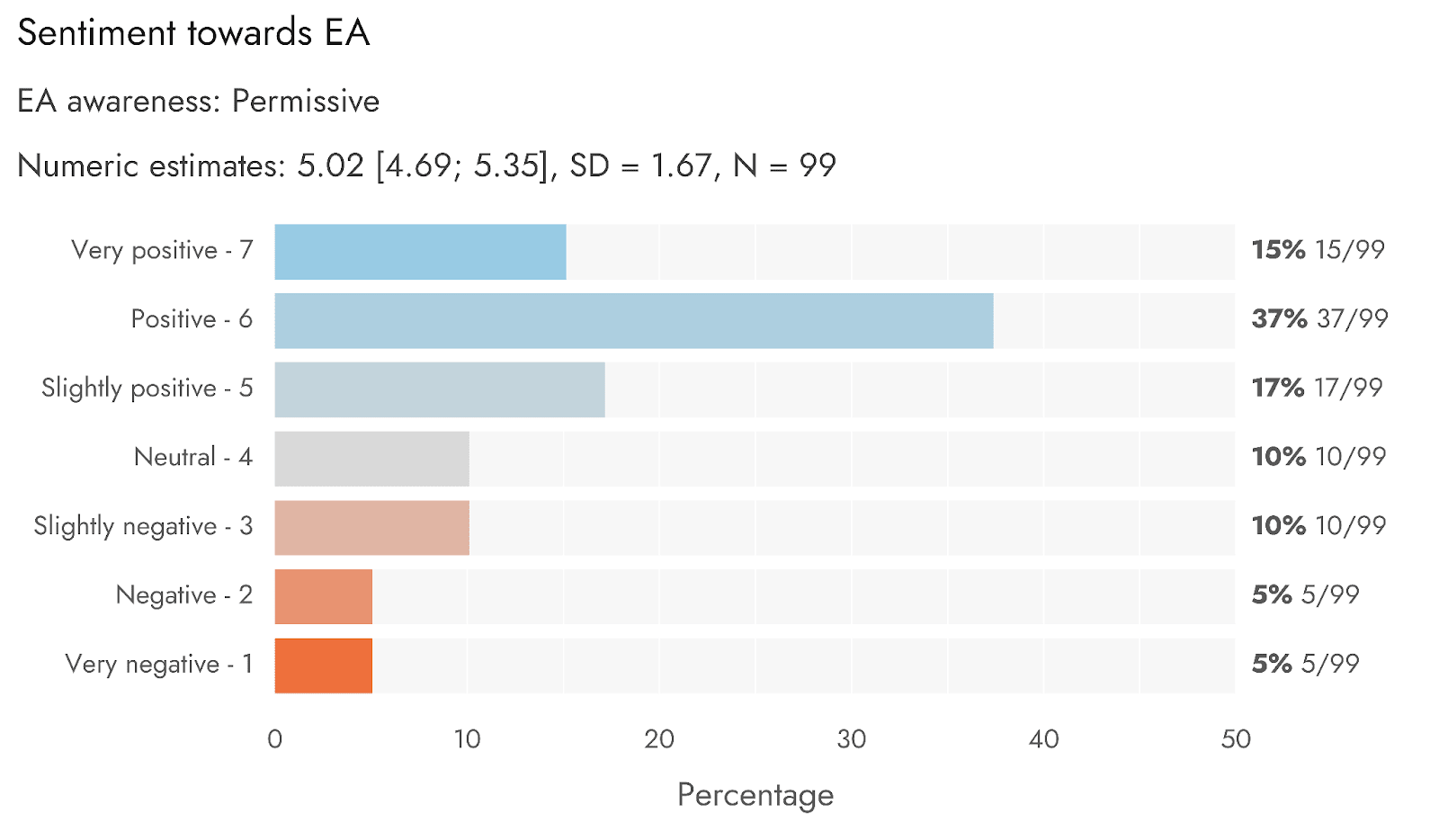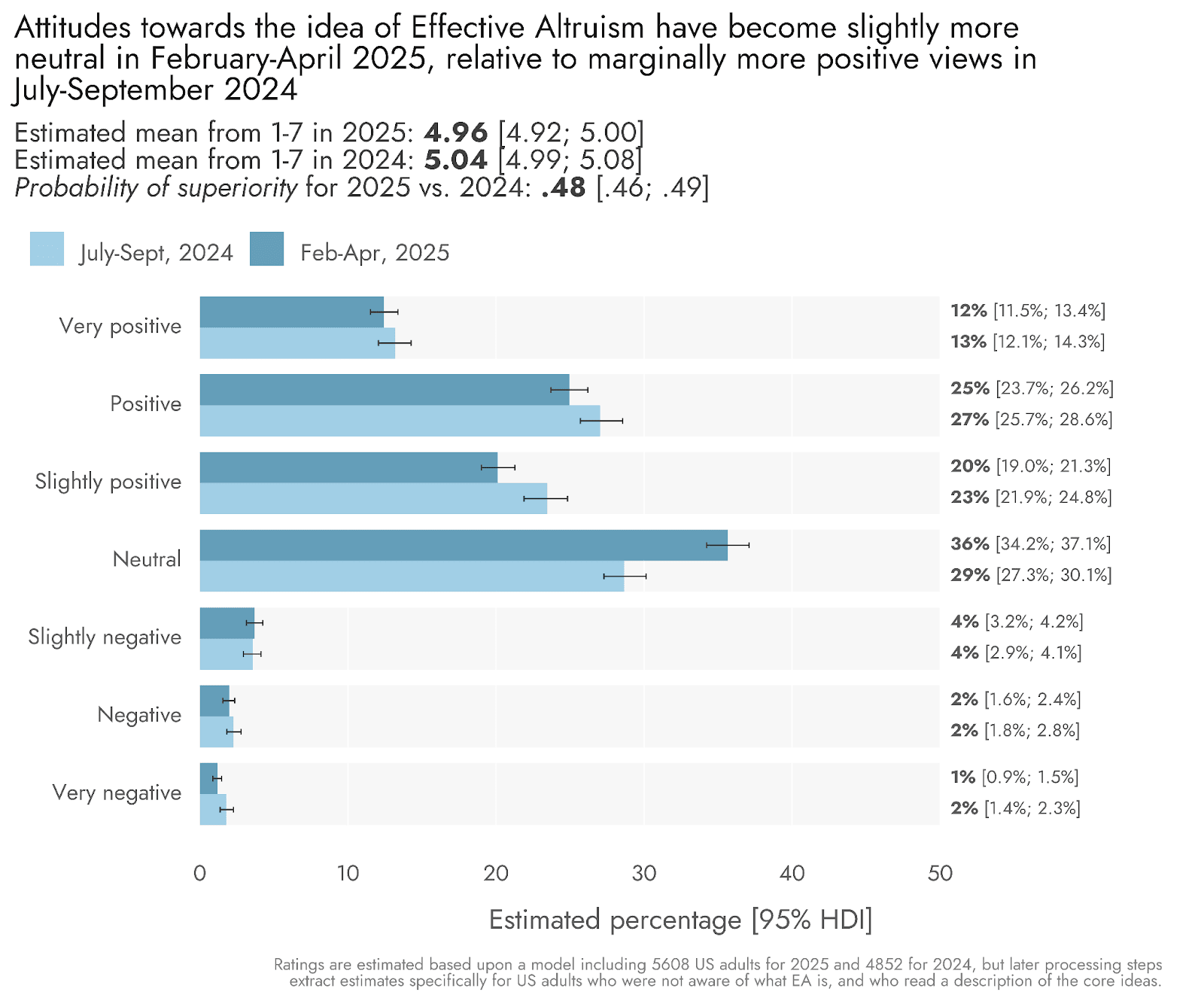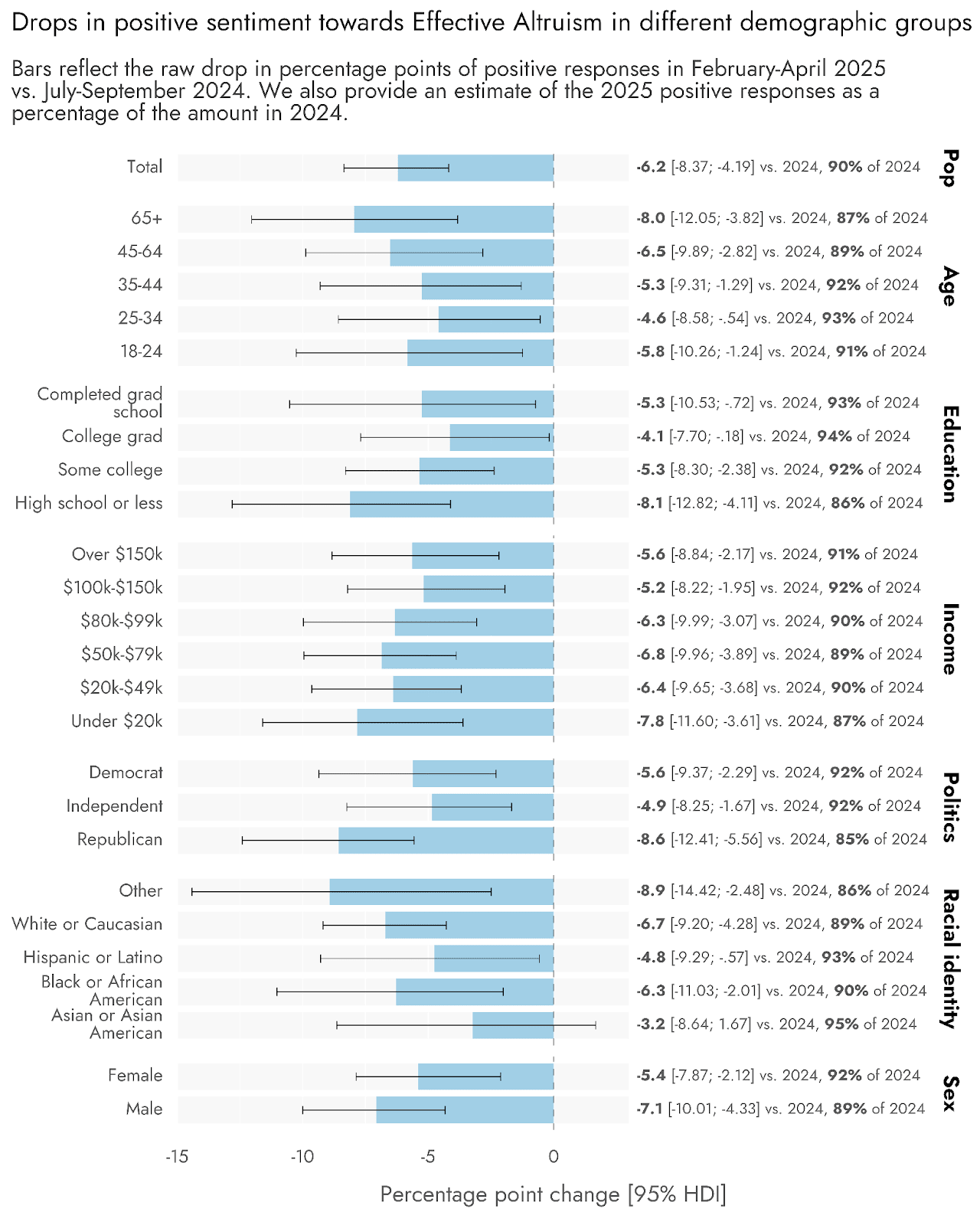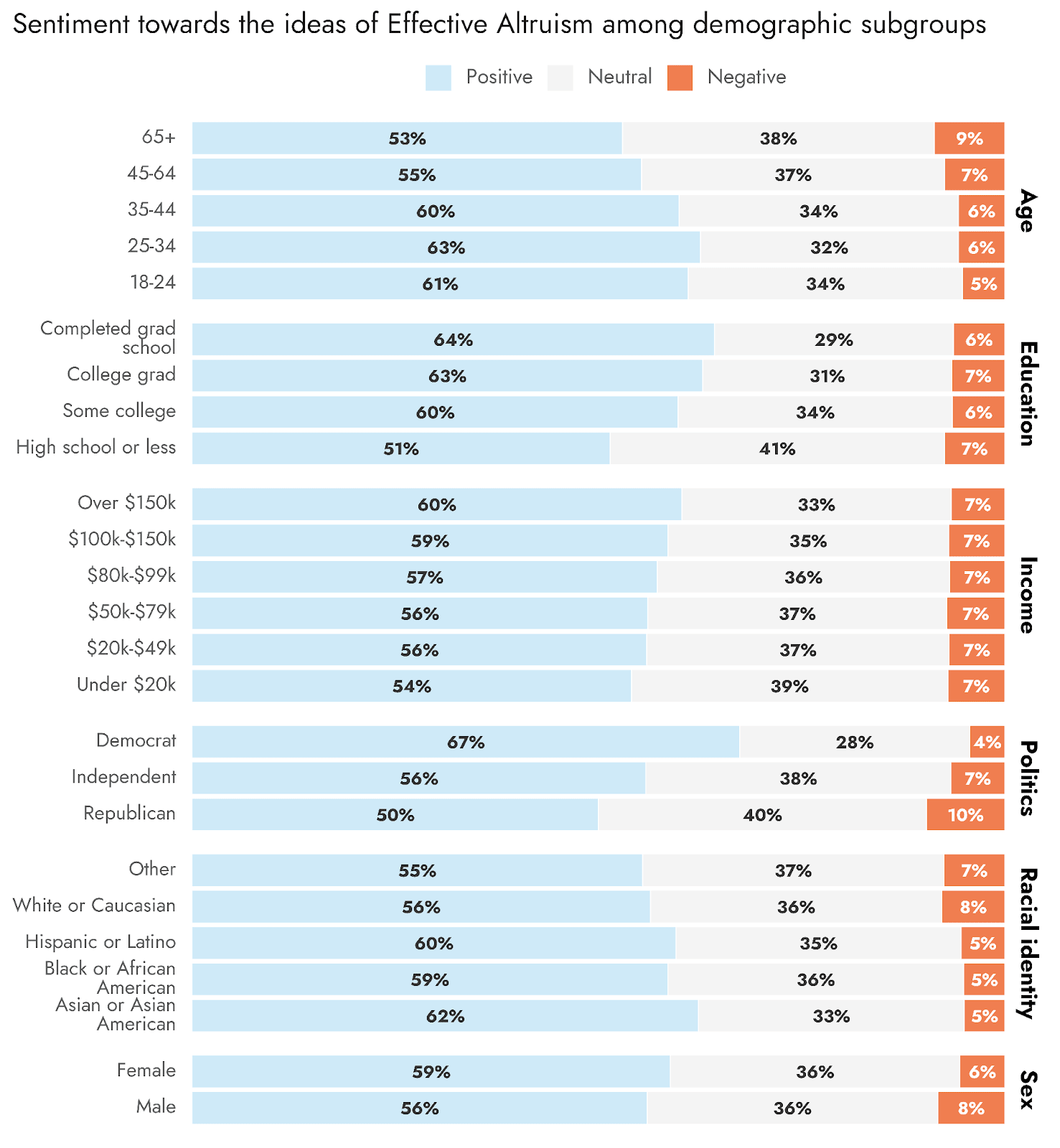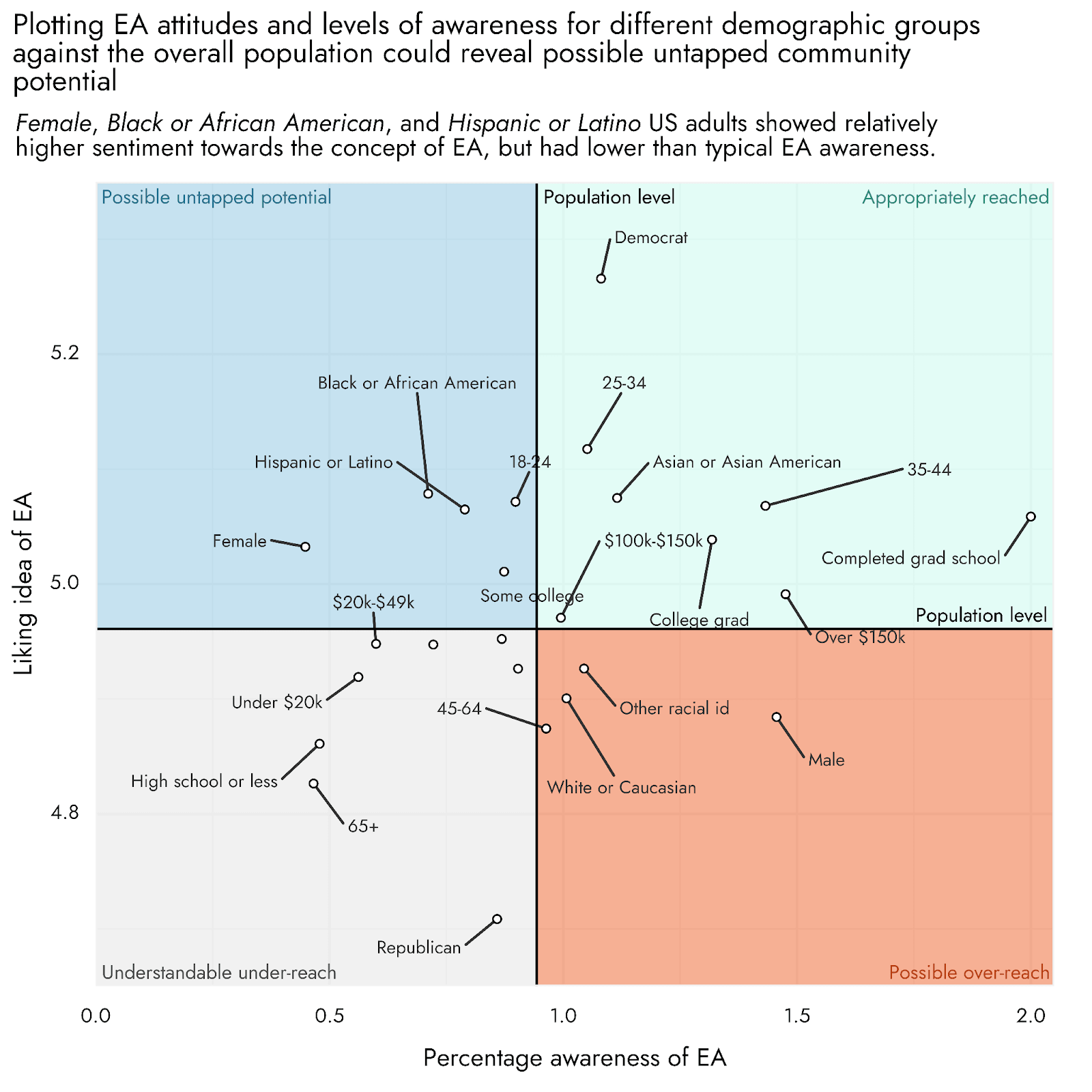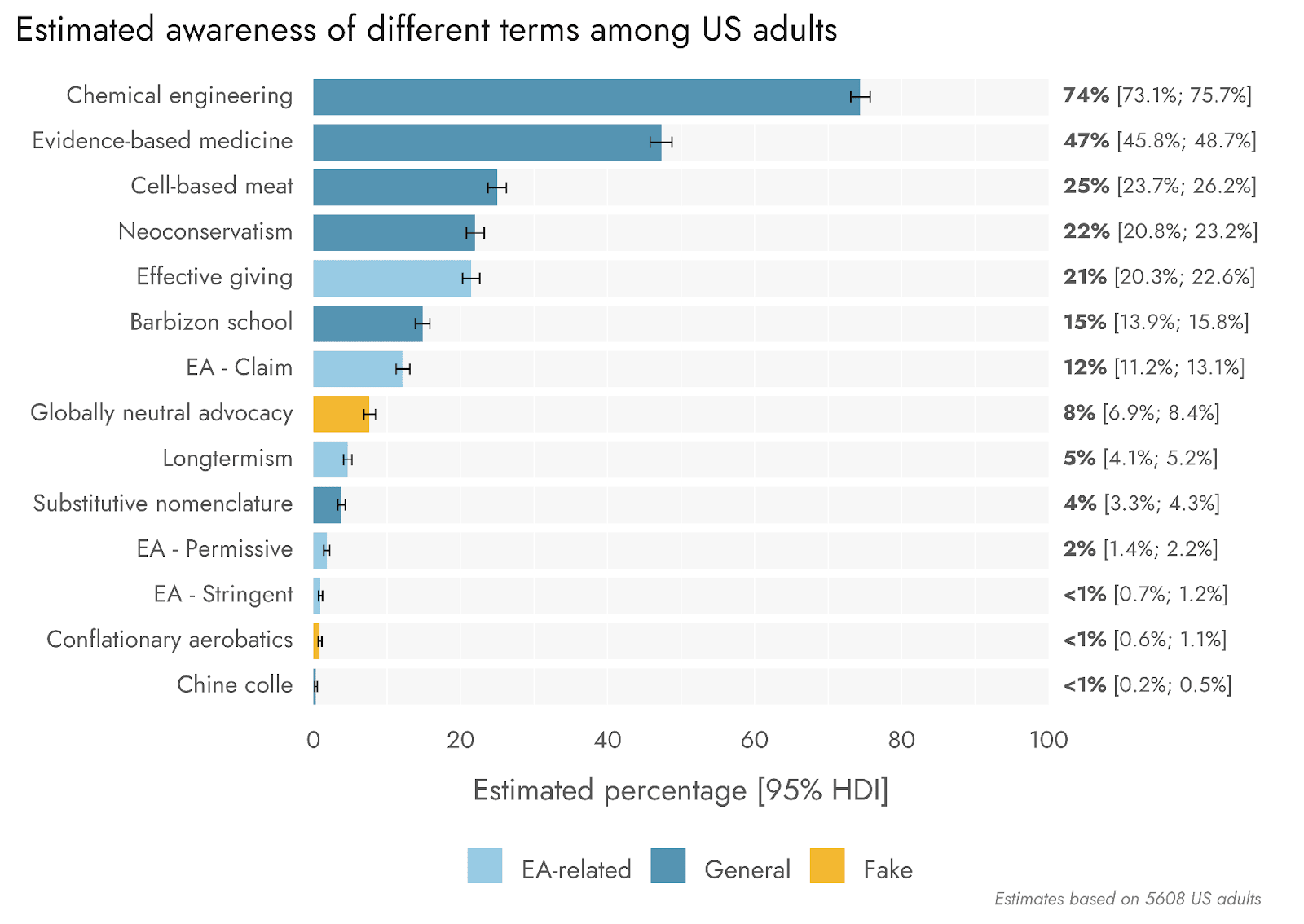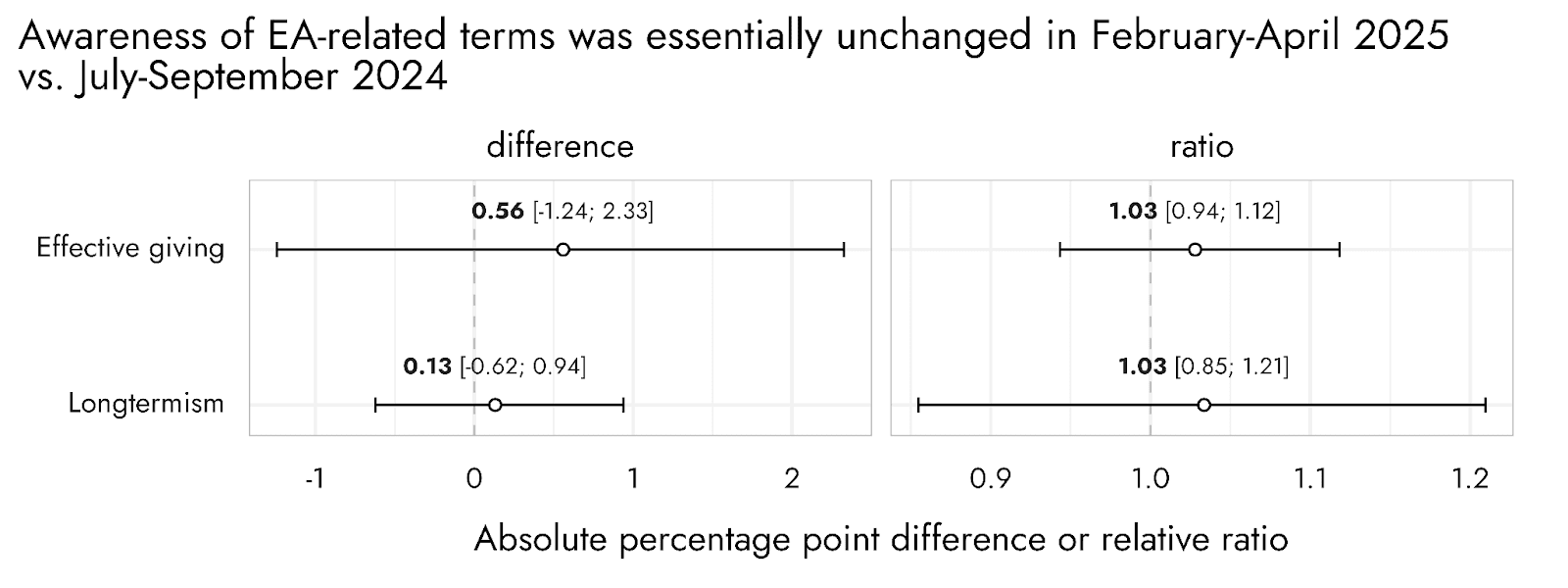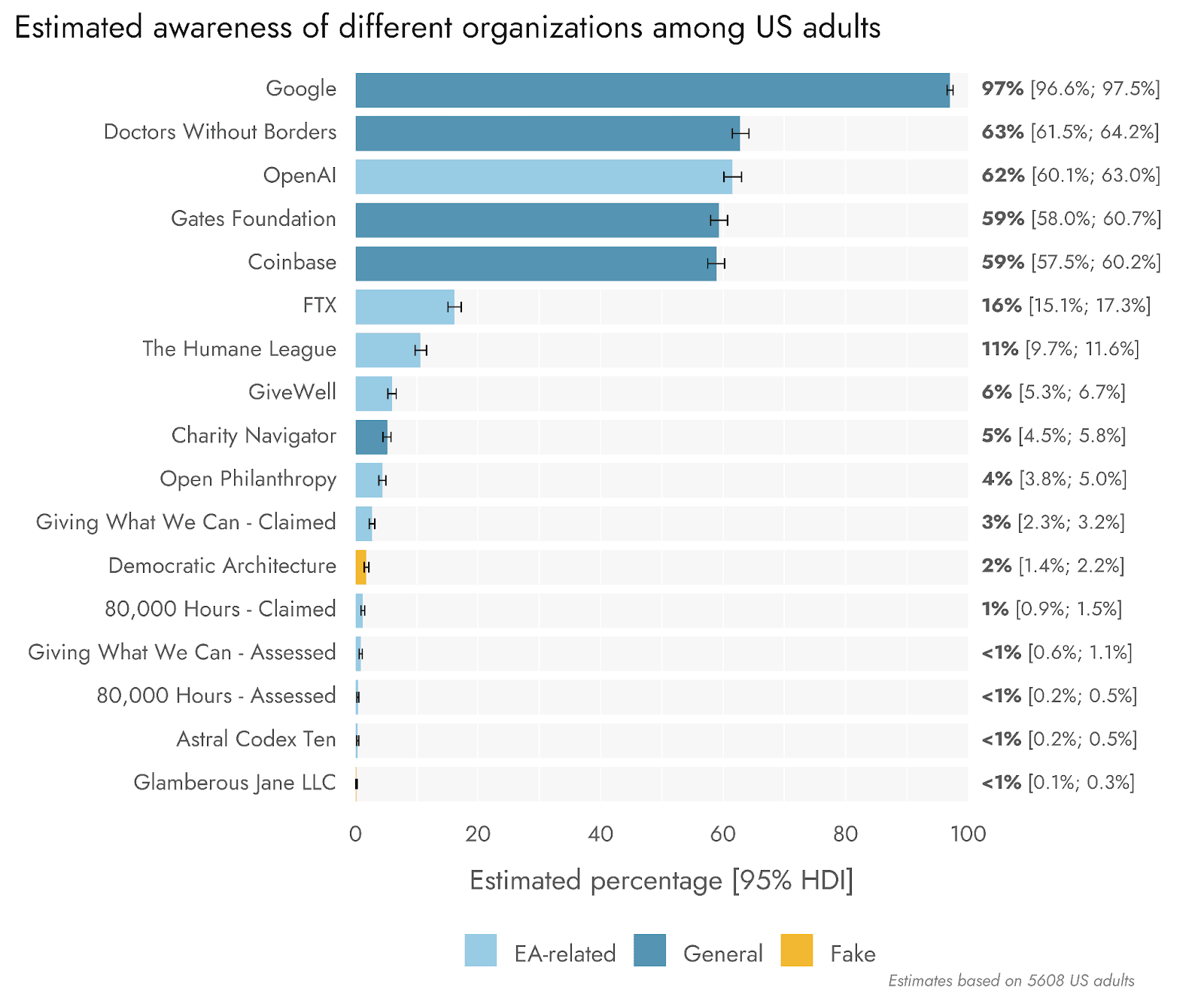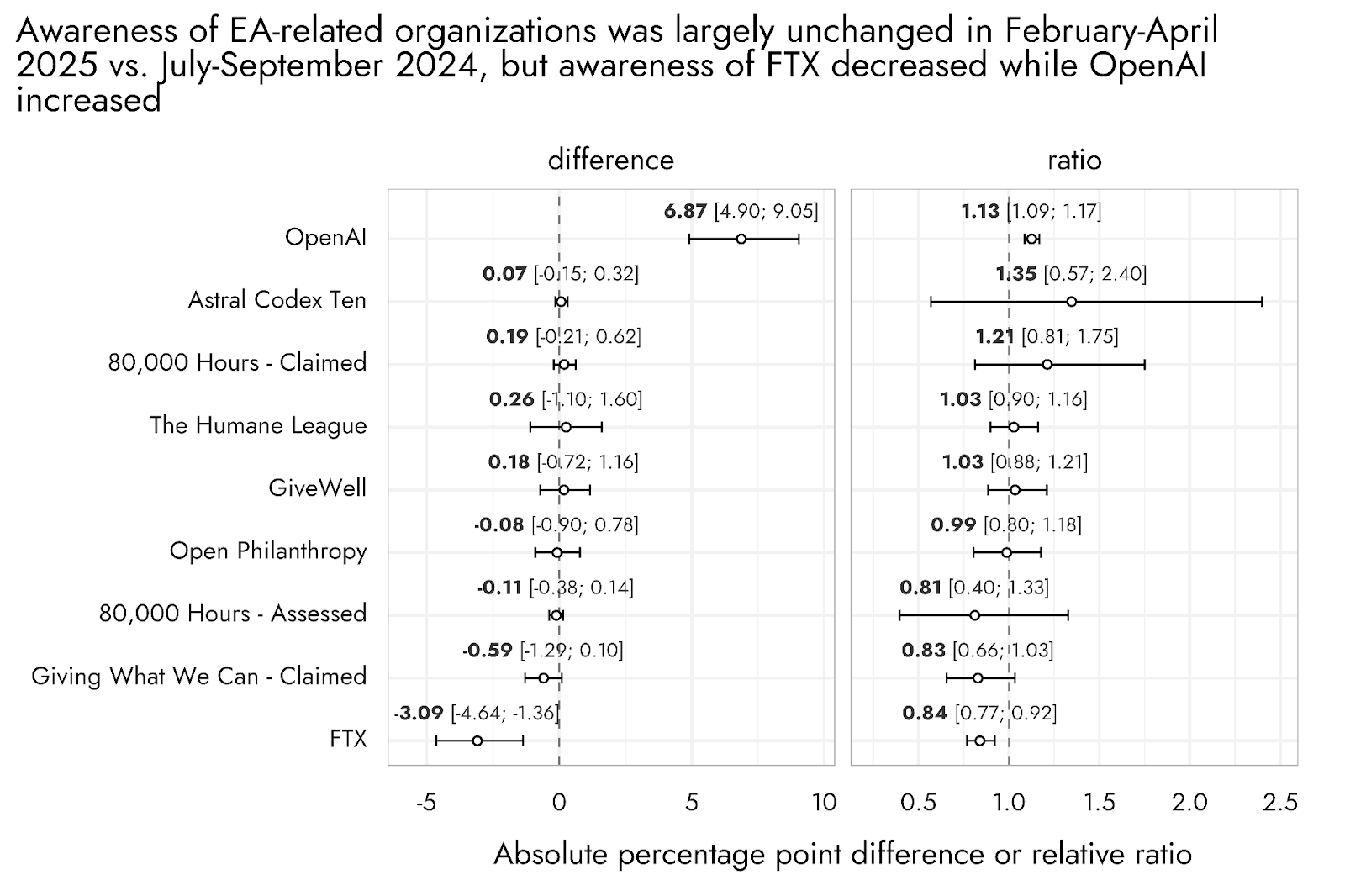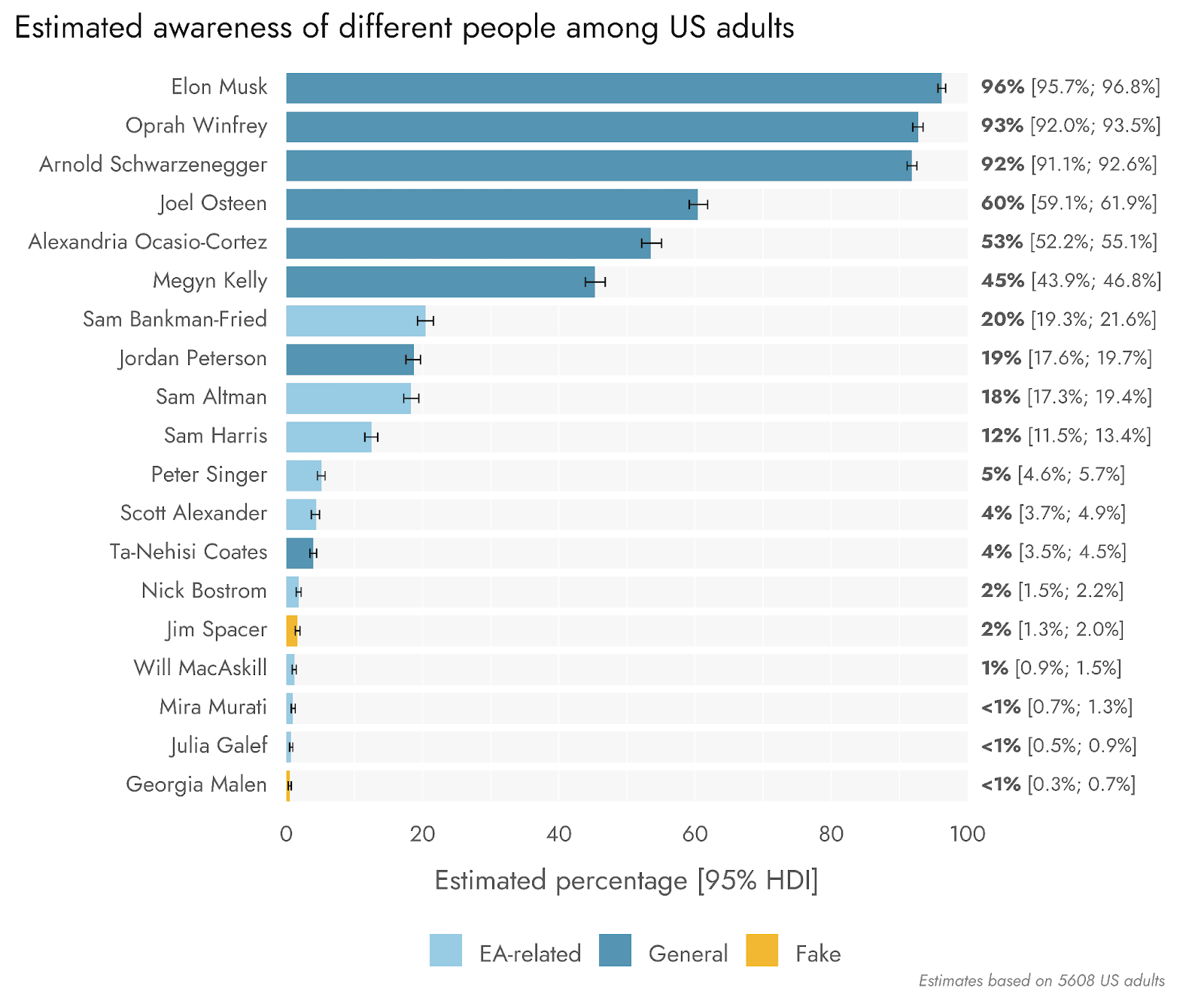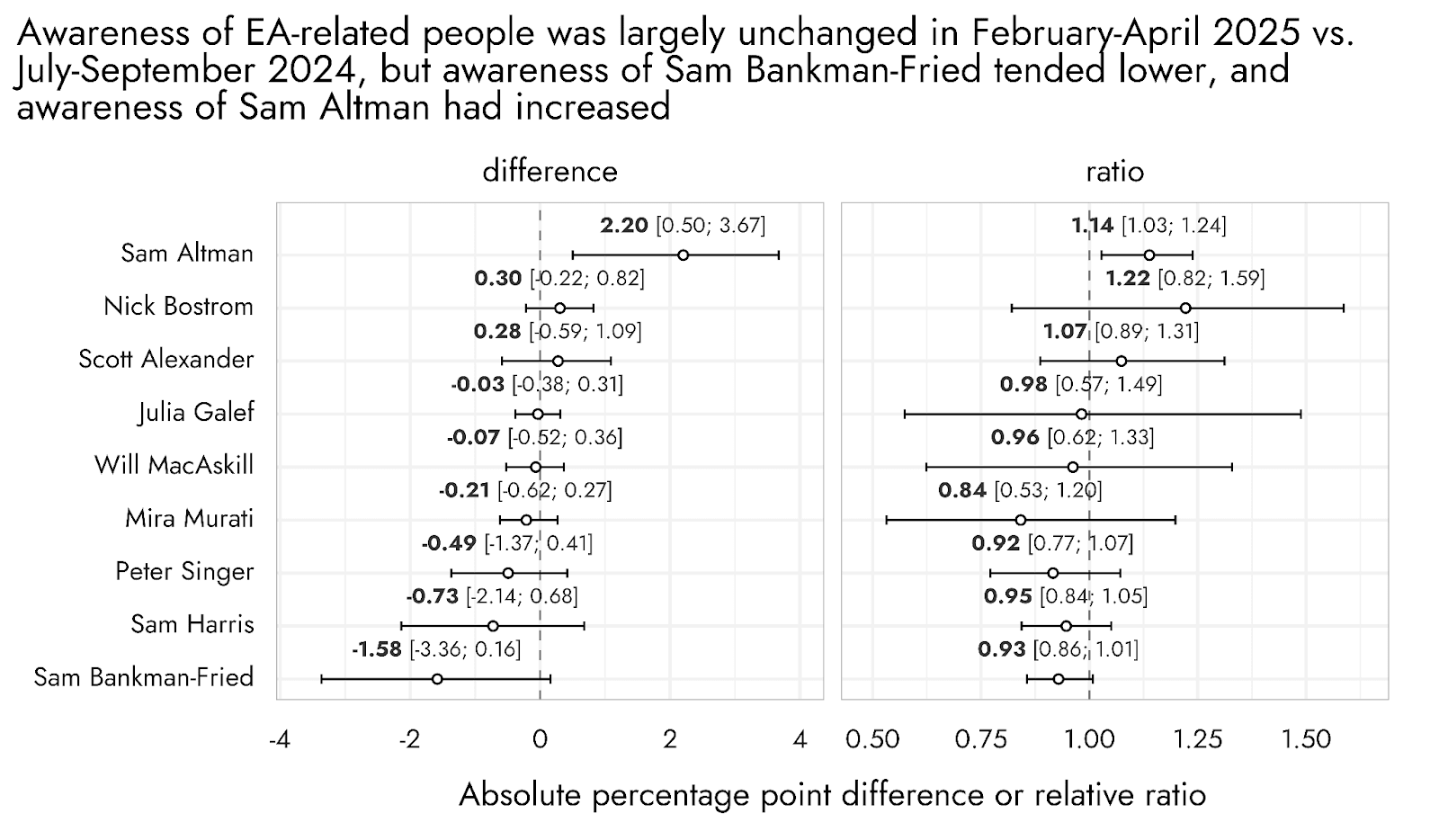Wave 2 of Pulse: Awareness and perceptions of Effective Altruism
By Jamie E, David_Moss @ 2025-08-22T13:02 (+102)
This report is the first in a sequence reporting the results of Wave 2 of the Pulse project by Rethink Priorities (RP). Pulse is a large-scale survey of US adults aimed at tracking and understanding public attitudes towards effective giving and multiple impactful cause areas over time. Wave 2 of Pulse was fielded between February and April of 2025 with ~5600 respondents[1]. Results from our first wave of Pulse, fielded from July-September of 2024, can be found here, with the forum sequence version here.
This part of the Wave 2 sequence focuses on awareness of Effective Altruism (EA) and a range of related public figures and organizations, as well as attitudes towards EA.
Findings at a glance
Survey features:
- Wave 2 of Rethink Priorities’ Pulse project surveyed ~5,600 US adults between February–April 2025, following up on Wave 1 (July–September 2024).
- Results were poststratified to be representative of the US adult population with respect to Age, Sex, Income, Racial identification, Educational attainment, State and Census Region, and Political party identification.
Awareness of Effective Altruism (EA):
- 12% of US adults claimed to have heard of EA, but we estimate only 1–2% (Permissive) and ~1% (Stringent) with genuine awareness.
- These levels of awareness are similar to Wave 1.
- Awareness was higher among higher income, younger (25–45), male, and more formally educated respondents.
- Attendees of several top-ranked universities showed higher awareness than other university attendees.
Attitudes towards EA:
- Among those aware of EA, 65–70% held positive views, and 20–28% felt negative.
- Negative views may be partly explained by associations with scandals such as FTX, as awareness of FTX was associated with more negative attitudes.
- When presented with a description of some core EA ideas, US adults not previously aware of EA mostly responded positively (57%), while 36% were neutral, and 7% responded negatively.
- This sentiment among previously unaware respondents represents a small but detectable drop relative to Wave 1, most notable among Republicans, older adults, and those with less formal education. It will be interesting to see if this shift is sustained and whether sentiment might drop further.
- Combining awareness and sentiment may highlight potentially under-reached demographic groups for the EA community - for example, Female respondents and those with Hispanic/Latino or Black/African American racial identification reported higher sentiment towards the ideas of EA relative to the overall population, but had lower than average EA awareness.
Awareness of EA-related organizations and people:
- Awareness of mainstream charities and philanthropic organizations such as Doctors Without Borders (63%) and the Gates Foundation (59%) far outpaced that of EA-related orgs such as Open Philanthropy (4%), GiveWell (6%), Giving What We Can (<3%), and 80,000 Hours (~1%) .
- These levels were unchanged relative to Wave 1.
- Awareness of most EA-related public figures was similarly low and unchanged.
- Awareness of OpenAI (62%, +7 percentage points) and Sam Altman (18%, +2 percentage points) had both increased since Wave 1.
- Awareness of FTX (16%, -3 percentage points) and Sam Bankman-Fried (20%, -2 percentage points) was lower relative to Wave 1.
Awareness of Effective Altruism
Population-level estimation
We used multiple thresholds for estimating the number of people who have heard of EA. The “Claim” level reflects the percentage of people who would be expected to pick “Effective Altruism” as something they have heard of from the list of terms. This level is likely to substantially overestimate the number of people who have genuinely heard of EA—for example, many people appear to select the term on the basis of recognizing the constituent words (8% of people similarly claim to have heard of the invented term “Globally Neutral Advocacy”).
After selecting Effective Altruism from the list of terms, respondents had to indicate whether they thought they had at least a basic understanding of its meaning. If so, they were required to provide a brief explanation of their understanding of the term. These explanations were used to determine Permissive and Stringent levels of awareness. The Stringent level was reached when the respondent unambiguously referred to one or more of the core ideas of EA, such as maximizing the amount of good done, and doing so through charity or careers, or referring to figures associated with the EA movement (including reference to scandals or controversial figures). Copy-pasted or trivially paraphrased definitions from online sources were not counted. The Permissive level was reached if the respondent alluded to some core ideas, but with lower specificity than the Stringent level. This level is inclusive of those who would qualify as Stringent.
While we estimate that 12% of US adults might claim to be aware of EA, our Permissive estimate for awareness of EA is 1-2% of US adults, and less than 1% for Stringent assessment (Figure 1). These percentages of awareness are consistent with there being no reliable increases or decreases in awareness of EA relative to the first wave of Pulse (Figure 2).
Figure 1: Estimated percentage of US adults who have heard of EA
Figure 2: Awareness of EA-related terms has not reliably changed in February-April 2025 vs. July-September 2024
Demographic subgroup estimates
Estimates of EA awareness across different demographic subgroups provide additional insight into how the concept of Effective Altruism reaches different social and demographic subpopulations (see Figures 3 and 4 for subgroup breakdowns of Stringent and Permissive awareness, respectively). Consistent with previous observations, higher levels of completed formal education were associated with greater EA awareness, matching outreach that has typically focused on highly educated individuals. Awareness peaked between people aged 25–45, and was lowest among those aged 65 and above. A clear income-related trend was also apparent, with awareness rising in conjunction with increasing income. Male respondents were substantially (2-3x) more likely to be aware of EA than female respondents. We previously observed a tendency for respondents identifying as Democrats to have higher awareness than Republicans, but variation in awareness across party identifications appeared to have leveled out slightly. Differences across respondent racial identification also appeared to have closed slightly, with no single comparison between identities revealing reliably higher or lower awareness.
Figure 3: Demographic breakdowns for estimated awareness of EA (Stringent)
Figure 4: Demographic breakdowns for estimated awareness of EA (Permissive)
Among particular niche populations, levels of EA awareness could be appreciably higher than some of the subgroup breakdowns above. For example, we observed that, even among people with university education, those who had attended a select subset of “elite”[2] universities tended to have higher levels of EA awareness than those who had not (Figure 5).[3]
Figure 5: University attendees who attended an “elite” institution had significantly higher awareness of Effective Altruism
Attitudes towards Effective Altruism
Attitudes among those who have already heard of EA
In addition to awareness, we assessed attitudes towards Effective Altruism. Among those aware at the Stringent (Figure 6) and Permissive (Figure 7) levels, attitudes were largely positive, with 65%-70% of those aware reporting at least slightly positive attitudes. These levels of sentiment do not reliably differ from the attitudes reported by respondents in July-September of 2024.[4]
However, a non-negligible minority (20%-28%) of respondents who were aware of EA felt negative towards it. Some such negative sentiment may be explained by continued associations of EA with scandals such as FTX: those who were aware of FTX gave significantly lower ratings of EA than those who were not (Stringent: 4.4 vs. 5.6, Mann-Whitney U p = .008; Permissive: 4.5 vs. 5.5 Mann-Whitney U p = .01).
Figure 6: Sentiment towards EA among those with a Stringent level of awareness
Figure 7: Sentiment towards EA among those with a Permissive level of awareness
Attitudes among those who have not heard of EA
At the end of the survey, respondents who had not heard of Effective Altruism were presented with a few sentences describing what it means in simple terms:
“Effective altruism is a philosophy and a community. Effective altruists use reasoning and evidence to find the most effective ways of doing good, and then act upon what they find to try to improve the world. For example, assessing how much impact different charities have for every dollar donated, and then promoting the most cost-effective charities.
It mostly advocates for supporting charities working on global poverty, factory farming, or risks to the long term future, such as artificial intelligence.”
Figure 8 shows how positive or negative we would expect the subset of US adults who have not heard of EA to feel about it, based on the above definition, as well as ratings from Wave 1 of Pulse for comparison. Only a small percentage (7%) of the population would respond negatively to this conception of EA, with 36% neutral and 57% positive. However, comparing sentiment ratings between Wave 1 and Wave 2 suggests a very small downward shift since our previous assessment, driven primarily by fewer people responding positively and more people providing neutral ratings. This shift is statistically detectable but corresponds substantively to a small-sized change. Nevertheless, it will be interesting to see if this decline in sentiment remains or even continues downwards in subsequent waves.[5]
Figure 8: Attitudes towards the idea of Effective Altruism have become slightly more neutral in February-April 2025, relative to marginally more positive views in July-September 2024
This drop in positive sentiment was present across almost all demographic subgroups, but was greatest among Republicans, older respondents, and those with lower levels of education (Figure 9). The drop among Republicans is notable because in Wave 1 of Pulse, Republicans were already the demographic with the lowest percentage of positive sentiment.
Figure 9. Drops in positive sentiment towards Effective Altruism in different demographic groups
Figure 10. Sentiment towards the ideas of Effective Altruism among demographic subgroups
Despite some slight changes over time, the general pattern across demographic subgroups in their attitudes towards the idea of EA remained similar to the first wave of Pulse, though with some group differences now accentuated: respondents identifying as Democrats were a lot more likely to hold a favorable view of the idea of EA than Republicans (67% vs. 50% positive, 4% vs. 10% negative), and we continued to see that older respondents held less favorable views of EA, as did those with lower levels of formal education.
In combination with our estimates of EA awareness, it is possible that these subgroup breakdowns also highlight some sources of untapped potential for the EA community (Figure 11). For example, relative to the population as a whole, Female, Black or African American, and Hispanic or Latino US adults tended to have higher sentiment towards the idea of EA, but lower than typical awareness. It might therefore be especially valuable to increase awareness of EA among these positively predisposed subpopulations. However, it also must be considered that these demographic groups could have even higher alignment with or sentiment towards other altruistic ideas or social movements. It could therefore be useful in upcoming research to more precisely assess sentiment towards EA ideas relative to other compelling but possibly competing ideas.
Figure 11. Plotting EA attitudes and levels of awareness for different demographic groups against the overall population could reveal possible untapped community potential
Awareness of EA-related terms, organizations, and people
Terms
We asked respondents about several other terms besides Effective Altruism. “Longtermism” and “Effective giving” were chosen due to their relevance to the EA community. Other items items functioned as reference points (e.g., broadly science-related or intellectual terms such as Evidence-based medicine), or as lures with which to gauge the extent to which people will claim awareness of terms just due to recognizing plausible combinations of words (e.g., Globally neutral advocacy).
Beyond Effective Altruism specifically, awareness of Effective giving stood quite high at 21% (Figure 12). However, we suspect the majority of this claimed awareness does not reflect real awareness of Effective giving as the formal process of evaluating or prioritizing among giving opportunities in terms of cost-effectiveness. Instead, it likely reflects claimed awareness of the general idea of “giving that is effective” without having encountered the actual concept or movement. Longtermism continues to show low awareness levels, with 5% claiming awareness—lower than a plausible-sounding but invented term “Globally neutral advocacy.”
Figure 12: Estimated awareness of different terms among US adults
These levels of awareness for Effective giving and Longtermism do not reliably differ from the levels we observed in Wave 1 of Pulse (Figure 13).
Figure 13: Awareness of EA-related terms was essentially unchanged in February-April 2025 vs. July-September 2024
Organizations
Estimated awareness of different organizations is presented in Figure 14. For organizations and public figures, we’ve categorized some as EA-related. This does not imply any official affiliation between them and the Effective Altruism community, nor endorsement from organizations/figures of Effective Altruism, and vice versa. The term EA-related is used purely descriptively to indicate a general association (e.g., GiveWell is counted as EA-related because it uses reason and evidence to find and promote the most cost-effective charities, whereas OpenAI—along with current or former members of its executive suite—is counted as EA-related due to Effective Altruism’s links with AI safety, and current or former board members reportedly motivated by EA principles).
As with awareness of EA-related terms, awareness of organizations—especially niche ones—is likely lower than the percentages presented below. For Giving What We Can (GWWC) and 80,000 Hours, we included a follow-up, multiple-choice assessment to determine whether people who claimed to have heard of the organization could select what it did from a list of options, and found that this lowers the level of apparent awareness. In both of these cases, claimed and assessed awareness were low (<5%). Awareness of other EA-aligned or related organizations was substantially lower than that of large, more traditional charitable or philanthropic organizations such as the Gates Foundation (59%) and Doctors Without Borders (63%).
The two most highly recognized EA-related organizations were OpenAI (62%) and—at considerably lower levels—FTX (16%, FTX being the defunct cryptocurrency exchange whose CEO, Sam Bankman-Fried, publicly promoted Effective Altruism). Whereas all other EA-related organizations maintained similar levels of awareness to July-September of 2024, we observed that awareness of OpenAI had risen, and FTX had declined (Figure 15). This makes sense given the increasing popularity of OpenAI’s flagship LLM “ChatGPT.” In contrast, as the FTX scandal recedes, it is likely that memory and awareness of it and related actors will decrease over time.
Figure 14: Estimated awareness of different organizations among US adults
Figure 15: Awareness of EA-related organizations was largely unchanged in Q1 2025 vs. Q3 2024, but awareness of FTX decreased while OpenAI increased
People
Estimated awareness of different public figures is presented in Figure 16. Figures very strongly associated with the EA community continue to have relatively low levels of public awareness. However, Sam Harris—a public intellectual who has repeatedly promoted or discussed EA ideas in his podcasts and written work—reached 12%. Figures such as Will MacAskill and Nick Bostrom, though widely recognized within the EA community, had recognition at levels similar to a fake “lure” item of only around 1-2%. These awareness estimates suggest that Effective Altruism and its related organizations and figures remain quite niche in the general public consciousness of the US.
Mirroring our observations of EA-related organizations, there was little, if any, change in awareness of EA-related figures, with the exception of Sam Altman and Sam Bankman-Fried (Figure 17). As CEO of OpenAI, it is understandable that awareness of Sam Altman would increase in step with the company he leads. Conversely, awareness of Sam Bankman-Fried, former CEO of FTX, was declining with the awareness of the company.
Figure 16: Estimated awareness of different people among US adults
Figure 17: Awareness of EA-related people was largely unchanged in February-April 2025 vs. July-September 2024, but awareness of Sam Bankman-Fried tended lower, and awareness of Sam Altman had increased
Rethink Priorities is a think-and-do tank dedicated to informing decisions made by high-impact organizations and funders across various cause areas. We invite you to explore our research database and stay updated on new work by subscribing to our newsletter.
Jamie Elsey conducted analyses and wrote this report, with editing and review from David Moss.
- ^
The exact number of respondents used in each analysis can vary, owing to non-usability or non-response for some questions, or splitting of respondents across different experimental conditions.
- ^
"Elite" universities were defined as those in the 20 highest ranked US universities according to the U.S. News College Compass, plus Swarthmore College (USA), Tufts University (USA), University of Oxford (UK), University of Cambridge (UK), and The London School of Economics and Political Science (UK).
- ^
Chi-square tests of association for both Permissive and Stringent awareness levels were statistically significant, with p-values of .0265 and .0019 for permissive and stringent respectively.
- ^
Mann-Whitney U-tests for stringent and permissive assessments yielded p-values of .55 and .28 respectively. A permutation test purely on the observed responses indicated that Probability of Superiority values for the observed changes over time—estimated at .54 and .45 for stringent and permissive assessments—would sit at the 73rd and 13th percentiles in a chance distribution of change over time, indicating a lack of reliable changes over time.
- ^
In principle, one must also consider that the composition of people who have not heard of EA could change over time as more people become aware of the concept. However, with current small proportions and the absence of changes in those proportions of people who have heard of EA, this is far from a practical concern.
Ben_West🔸 @ 2025-08-24T19:44 (+39)
Thanks for doing this. I was interested in how these results compare to other movements, so I tried to get a historical dataset. It seems like EA is doing pretty well.
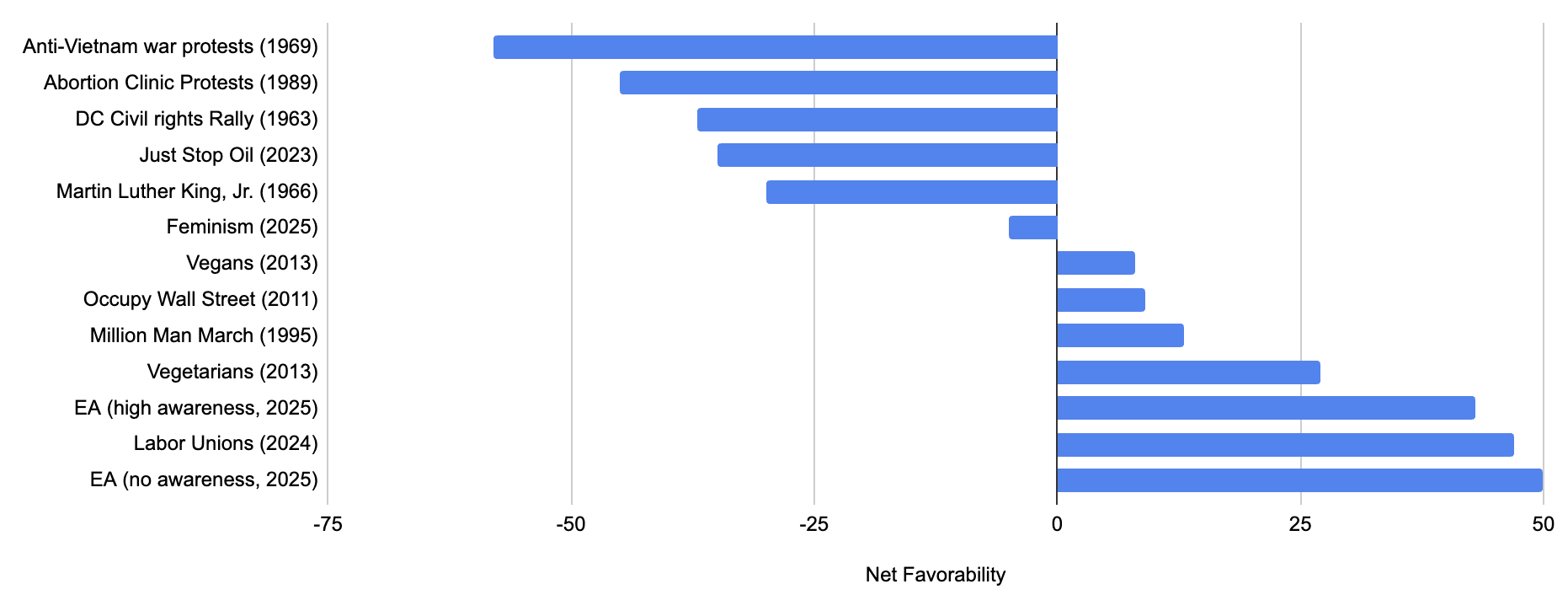
Data here. This was a quick project, not a thorough search.
I'm not sure how much this would drive up your costs, but if you ever are able to, I would be interested to hear favorability statistics amongst your sample for some of the entities you ask about awareness. E.g. I would be interested to hear how EA's favorability compares to the favorability of the Gates Foundation or Google.
David_Moss @ 2025-08-25T11:32 (+10)
Thanks Ben!
I think we should be able to do this[1] and I agree it seems interesting. It looks like Google has quite high favourability and Bill Gates personally (I did not see recent numbers for the Gates Foundation), reasonably high, but lower.
- ^
Though there is some complication around whether we're looking at the sentiment of (i) people who've been assessed as truly being aware (most comparable to our attitudes among those who have already heard question, but would need an additional test for those respondents), (ii) people who've not claimed awareness (most comparable to our attitudes among those who have not heard question but less relevant).
Ben_West🔸 @ 2025-08-25T16:12 (+6)
Some such negative sentiment may be explained by continued associations of EA with scandals such as FTX: those who were aware of FTX gave significantly lower ratings of EA than those who were not (Stringent: 4.4 vs. 5.6, Mann-Whitney U p = .008; Permissive: 4.5 vs. 5.5 Mann-Whitney U p = .01).
Would you be able to share what fraction of those with negative EA associations were aware of FTX?
Jamie E @ 2025-08-26T10:31 (+10)
Sure, that's a nice/other way of looking at the relationship that is informative, we might include this in the final report. You can see for the permissive assessment its the majority of those with a negative view being aware of FTX.
I think it's important to note that this doesn't mean that 'if more people who currently hold positive views of EA were aware of FTX then they would have negative views' - because it's possible that for some or many of those negative views, perhaps the only or primary way in which they've been exposed to the idea of EA is through the lens of FTX.
